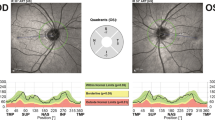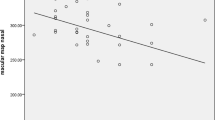Abstract
Background and aim
In a previous study, retinal nerve fiber layer thickness (RNFLT) loss was shown as part of the neurodegenerative process in multiple system atrophy (MSA). Here, we investigate in a larger cohort of MSA patients whether the RNFLT loss translates into respective visual field defects.
Methods
Spectral domain optical coherence tomography was performed in 20 MSA patients (parkinsonian subtype = 12, cerebellar subtype = 8) to quantify peripapillary RNFLT. Visual field (90°) was analyzed by automated static perimetry to investigate retinal structure/function relationship. Eight data sets did not meet stringent quality criteria, and only 12 data sets were further analyzed.
Results
Compared to healthy controls, MSA patients demonstrated a significant reduction of RNFLT in the nasal sectors (p nasal-superior = 0.02, p nasal = 0.03, p nasal-inferior < 0.01), while changes in temporal RNFLT measures (p temporal-superior = 0.42, p temporal = 0.34, p temporal-inferior = 0.25) were not statistically significant compared to healthy controls (ANOVA). MSA patients featured a significant global mean deviation (2.74 dB; p < 0.01) without predominant peripheral visual field defects. Statistical analysis of mean defect in the central (0–30°), peripheral (30–90°) or global (0–90°) visual field revealed no significant correlation (r 2 central = 0.11, r 2 peripheral = 0.04, r 2 global = 0.07) with nasal RNFLT in MSA patients.
Conclusion
MSA patients feature significant reduction in nasal RNFLT and global mean deviation when compared to healthy controls, consistent with the multi-systemic nature of this neurodegenerative disorder. This finding provides first evidence for two independent deteriorations of the visual system in MSA.



Similar content being viewed by others
References
Wenning GK, Colosimo C, Geser F, Poewe W (2004) Multiple system atrophy. Lancet Neurol 3:93–103
Fischer MD, Synofzik M, Heidlauf R, Schicks J, Srulijes K, Kernstock C, Berg D, Schols L, Schiefer U (2011) Retinal nerve fiber layer loss in multiple system atrophy. Mov Disorders 26:914–916
Pula JH, Towle VL, Staszak VM, Cao D, Bernard JT, Gomez CM (2011) Retinal nerve fibre layer and macular thinning in spinocerebellar ataxia and cerebellar multisystem atrophy. Neuro-Ophthalmolgy 35:108–114
Parisi V, Restuccia R, Fattapposta F, Mina C, Bucci MG, Pierelli F (2001) Morphological and functional retinal impairment in Alzheimer’s disease patients. Clin Neurophysiol 112:1860–1867
Parisi V, Manni G, Spadaro M, Colacino G, Restuccia R, Marchi S, Bucci MG, Pierelli F (1999) Correlation between morphological and functional retinal impairment in multiple sclerosis patients. Invest Ophthalmol Vis Sci 40:2520–2527
Pasol J (2011) Neuro-ophthalmic disease and optical coherence tomography. Glaucoma look-alikes. Curr Opin Ophthalmol 22:124–132
Inzelberg R, Ramirez JA, Nisipeanu P, Ophir A (2004) Retinal nerve fiber layer thinning in Parkinson disease. Vision Res 44:2793–2797
Altintas O, Iseri P, Ozkan B, Caglar Y (2008) Correlation between retinal morphological and functional findings and clinical severity in Parkinson’s disease. Doc Ophthalmol 116:137–146
Sample PA, Johnson CA (2003) Visual perception. In: Kaufman PL, Alm A (eds) Adler’s physiology of the eye. Mosby, St. Louis, pp 441–600
Gilman S, Wenning GK, Low PA, Brooks DJ, Mathias CJ, Trojanowski JQ, Wood NW, Colosimo C, Durr A, Fowler CJ, Kaufmann H, Klockgether T, Lees A, Poewe W, Quinn N, Revesz T, Robertson D, Sandroni P, Seppi K, Vidailhet M (2008) Second consensus statement on the diagnosis of multiple system atrophy. Neurology 71:670–676
Osaki Y, Ben-Shlomo Y, Lees AJ, Wenning GK, Quinn NP (2009) A validation exercise on the new consensus criteria for multiple system atrophy. Mov Disord 24: 2272-2276
Helb HM, Charbel Issa P, Fleckenstein M, Schmitz-Valckenberg S, Scholl HP, Meyer CH, Eter N, Holz FG (2010) Clinical evaluation of simultaneous confocal scanning laser ophthalmoscopy imaging combined with high-resolution, spectral-domain optical coherence tomography. Acta Ophthalmol 88:842–849
Schiefer U, Pascual JP, Edmunds B, Feudner E, Hoffmann EM, Johnson CA, Lagreze WA, Pfeiffer N, Sample PA, Staubach F, Weleber RG, Vonthein R, Krapp E, Paetzold J (2009) Comparison of the new perimetric GATE strategy with conventional full-threshold and SITA standard strategies. Invest Ophthalmol Vis Sci 50:488–494
Sample PA, Dannheim F, Artes PH, Dietzsch J, Henson D, Johnson CA, Ng M, Schiefer U, Wall M (2011) Imaging and perimetry society standards and guidelines. Optom Vis Sci 88:4–7
Spry PG, Johnson CA, Mansberger SL, Cioffi GA (2005) Psychophysical investigation of ganglion cell loss in early glaucoma. J Glaucoma 14:11–19
Safran AB (1997) Scotomas: assessment by the patient and by the physician. There’s nothing to see. Klin Monatsbl Augenheilkd 210:316–318
Murakami I, Komatsu H, Kinoshita M (1997) Perceptual filling-in at the scotoma following a monocular retinal lesion in the monkey. Visual Neurosci 14:89–101
Jansonius NM, Nevalainen J, Selig B, Zangwill LM, Sample PA, Budde WM, Jonas JB, Lagreze WA, Airaksinen PJ, Vonthein R, Levin LA, Paetzold J, Schiefer U (2009) A mathematical description of nerve fiber bundle trajectories and their variability in the human retina. Vision Res 49:2157–2163
Kerrigan-Baumrind LA, Quigley HA, Pease ME, Kerrigan DF, Mitchell RS (2000) Number of ganglion cells in glaucoma eyes compared with threshold visual field tests in the same persons. Invest Ophthalmol Vis Sci 41:741–748
Yenice O, Onal S, Midi I, Ozcan E, Temel A, I-Gunal D (2008) Visual field analysis in patients with Parkinson’s disease. Parkinsonism Relat Disord 14:193–198
Kurtenbach A, Leo-Kottler B, Zrenner E (2004) Inner retinal contributions to the multifocal electroretinogram: patients with Leber’s hereditary optic neuropathy (LHON). Multifocal ERG in patients with LHON. Doc Ophthalmol 108:231–240
Disclosure
Ulrich Schiefer is Consultant of Haag–Streit, Koenitz, Switzerland. He developed several perimetric strategies, and holds patents in this field. The other authors report no conflicts of interest. The authors also have full control of all primary data, and agree to allow the journal to review the data on request.
Author information
Authors and Affiliations
Corresponding author
Electronic supplementary material
Below is the link to the electronic supplementary material.
Supplemental Fig. 1
Example of the visual field test protocol with results from an individual MSA patient. White-on-white perimetry was used with Goldmann III stimulus size at 200 ms stimulus duration and 1200 ms response time on a background-illumination set to 10 cd/m2. One hundred and nine stimuli were distributed in a polar pattern, with 58 stimuli within the central 30°. Interpolation data of responses are presented in areas of grey values, which indicate level of localized sensitivity defects (JPEG 34 kb)
High Resolution Image 1
(TIFF 3526 kb)
Supplemental Fig. 2
Pearson’s correlation analyses of global (left panels) and nasal (right panels) retinal nerve fiber layer thickness (RNFLT) with a-b disease duration in years, or c-d severity of disease as quantified by the united multiple system atrophy rating scale (UMSARS). No correlation reached statistical significance (p > 0.05); correlation coefficient r 2 is displayed in the upper left corner of each scatter graph (JPEG 43 kb)
High Resolution Image 2
(TIFF 489 kb)
Rights and permissions
About this article
Cite this article
Fischer, M.D., Synofzik, M., Kernstock, C. et al. Decreased retinal sensitivity and loss of retinal nerve fibers in multiple system atrophy. Graefes Arch Clin Exp Ophthalmol 251, 235–241 (2013). https://doi.org/10.1007/s00417-012-2118-1
Received:
Revised:
Accepted:
Published:
Issue Date:
DOI: https://doi.org/10.1007/s00417-012-2118-1




